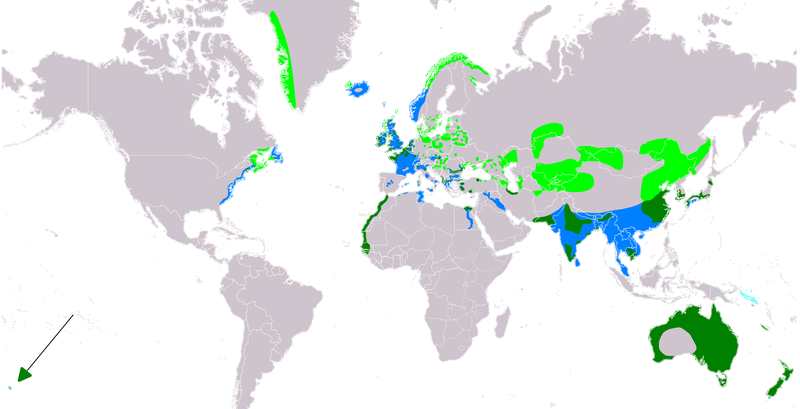Wednesday 19 January 2022
Sunday 16 January 2022
HOODED CROW or GREY CROW (Corvus cornix) attempting to remove a Common Periwinkle (Littorina littorea) from its shell at Broadmeadow Estuary, Malahide, Fingal, Co. Dublin, Ireland
Click external link here for detailed species information
Click external link here to see distribution map and to hear calls
The Hooded Crow (Corvus cornix) also known as Grey Crow is a member of the crow family Corvidae which is in the genus Corvus.
Four subspecies are generally recognized. Despite the fact that it is
heavily persecuted, it occurs throughout Western Asia including parts of
the Middle East as well as along the Nile Valley in North Africa. It is
also commonly encountered and has a widespread distribution in Northern, Central and Eastern
Europe. It is resident in Ireland, Isle of Man and Northern Scotland. In the rest of Britain as well as Southwestern and Western Europe, it is replaced by the
closely related Carrion Crow (Corvus corone) from which it was split in
2002 and was recognised as a separate species. Where their breeding ranges overlap, they may
hybridise. Some of the northern populations are migratory and move south for the winter.
Saturday 15 January 2022
COMMON GREENSHANK (Tringa nebularia) at Broadmeadow Estuary, Malahide, Fingal, Co. Dublin, Ireland

Tuesday 11 January 2022
BLACK REDSTART (Phoenicurus ochruros) immature at Balscadden Beach, Howth, Fingal, Co. Dublin, Ireland
The Black Redstart (Phoenicurus ochruros) is a small perching bird of the Old World flycatcher family Muscicapidae which is the genus Phoenicurus. It is a locally common resident in central and southern Europe as well as northern Africa. It also occurs in western and central Asia. In the warmer parts of its range it is sedentary. The northern populations migrate in the autumn to spend the winter in southern and western Europe, northern Africa and the Indian sub continent.
Patrick J. O'Keeffe / Raw Birds
Sunday 9 January 2022
COMMON CHIFFCHAFF (Phylloscopus collybita subspecies P. c. collybita) flycatching from the security fencing at the rear of Asgard Apartments, Balscadden Beach, Howth, Fingal, Co. Dublin, Ireland
The Common Chiffchaff (Phylloscopus collybita) is of the family Phylloscopidae which is in the genus Phylloscopus. This small insectivorous species of leaf warbler is a summer resident from mid March to October which breeds in the northern and temperate regions of Eurasia. In the autumn it migrates south to spend the winter in the Mediterranean Basin, sub Saharan Africa and southwestern Asia. Small numbers also overwinter in northwest Europe.
Thursday 6 January 2022
YELLOW LEGGED GULL (Larus michahellis) adult and a group of Black Headed Gulls (Chroicocephalus ridibundus) from 07-01-2022 to at least 03-02-2022 at Broadmeadow Estuary, Swords, Fingal, Co. Dublin, Ireland
- Larus michahellis michahellis - breeds in parts of western and southern Europe, as well as the Mediterranean Basin.
- Larus michahellis atlantis - known as Atlantic Gull, breeds on the Atlantic coasts of France, Iberia, Morocco, Canary Islands, Madeira as well as a dark headed form that occurs on the Azores.
Tuesday 4 January 2022
COMMON REDSHANK (Tringa totanus) at Broadmeadow Estuary, Swords, Fingal, Co. Dublin, Ireland

Saturday 1 January 2022
CONTINENTAL CORMORANT (Phalacrocorax carbo subspecies P. c. sinensis) immature on 1st January 2022 at Swords Sailing Club, Broadmeadow Estuary, Malahide, Fingal, Co. Dublin, Ireland
- Broadmeadow Estuary, Swords, 1st winter from 4th to 30th January 2013.
- Broadmeadow Estuary, Swords, 1st winter from 28th January to 16th May 2013, different from above.
- Scotsman Bay, Dunlaoire, adult on 1st February 2014.

Tuesday 14 December 2021
EURASIAN TREE SPARROW (Passer montanus) Turvey Nature Reserve, Donabate, Fingal, Co. Dublin, Ireland
Sunday 3 October 2021
GLOSSY IBIS (Plegadis falcinellus) adult from 29th September to 14th October 2021 at Turvey Nature Reserve, Donabate, Fingal, Co. Dublin, Ireland
Saturday 2 October 2021
EUROPEAN GOLDFINCH (Carduelis carduelis) 1st winter Turvey Nature Reserve, Donabate, Fingal, Co. Dublin, Ireland
Patrick J. O'Keeffe / Raw Birds
Thursday 30 September 2021
LITTLE GREBE or DABCHICK (Tachybaptus ruficollis) Turvey Nature Reserve, Donabate, Fingal, Co. Dublin, Ireland
Click external link here to see distribution map and to hear calls
Patrick J. O'Keeffe / Raw Birds
Wednesday 29 September 2021
MALLARD (Anas platyrhynchos) female and Little Grebe (Tachybaptus ruficollis) in the background Turvey Nature Reserve, Donabate, Fingal, Co. Dublin, Ireland
Saturday 25 September 2021
GREY HERON (Ardea cinerea) sheltering from the wind at Turvey Nature Reserve, Donabate, Fingal, Co. Dublin, Ireland
Friday 24 September 2021
Sunday 12 September 2021
RED BACKED SHRIKE (Lanius collurio) immature found by Mark Collins on 12-09-2021 was still present on 15th and is only the 5th Dublin record Upper Cliff Road, Balscadden, Howth, Co. Dublin, Ireland
The Red Backed Shrike (Lanius collurio) is of the family Laniidae which is in the genus Lanius. Its breeding range extends from Mainland Europe to Western Asia and in the autumn it migrates south to spend the winter in Southern Africa.





















%20distribution%20map.jpg)



